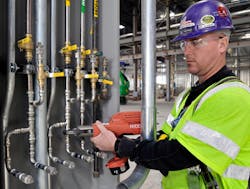Derek Bower is an associate product manager for Viega LLC, where he is responsible for new product development and deployment, product line management, and business planning for the North American market. Mr. Bower has 14 years of industry experience and is a certified Professional Engineer. He earned a bachelor’s degree in Mechanical Engineering from the University of Illinois.
Q: What do you see as the key recent advances in the area of pipe joining and associated technology? How is the process and technology for pipe joining today better than in the past?
A: Today, pipes and tubes can be joined without torches, welding equipment, or threading machines, while still meeting or exceeding required standards. Subsequently, a much cleaner installation is possible without affecting material properties in the process. Available in multiple materials to suit nearly any application, this technology can offer tremendous savings on time and labor.
Q: When specifying industrial pipe connections, what are some important considerations an end-user should make to ensure the appropriate pipe joining solution is used for the application?
A: Fitting and sealing element material selections should be based on the fluid within the piping system, as well as the environment outside of the piping system. Leak detection—allowing installers to detect unpressed connections before a system is commissioned—is also an important feature for users to specify.
Q: What are some common pitfalls you see end-users encountering when it comes to pipe joining in an industrial setting?
A: For many industrial users, welding can be a difficult and very time-consuming method of pipe joining, particularly in tight spaces. Once the correct material is chosen, pressing allows clean, flame-free pipe and tube joints in a fraction of the time.
Q: Regarding material selection, how can end-users best ensure they are choosing the appropriate material of construction for a given application?
A: Selecting the correct system materials is critical to system longevity. With materials including copper, bronze, 304 and 316 stainless steel, and sealing elements available in EPDM, FKM and HNBR, solutions are available for nearly any installation. We strongly encourage users to discuss their applications with a technical service expert—they can often recommend the fitting and sealing element materials to best suit the application.
Q: What are the typical failure modes for a pipe connection, and how can an end-user best ensure early identification and/or prevention of these failures?
A: Incomplete joining during system installation is a leading cause of failure for pipe connections. A pressure test will help identify incomplete joints, especially when used with fittings that incorporate such features. Installers can be confident of leak-free connections upon system commissioning.
Q: Looking into the future, are there any obvious evolutionary steps you see for pipe joining technology and/or the pipe joining process? How will the technology/process for pipe joining be better tomorrow than it is today?
A: We see press technology as a perfect solution for users who cannot afford downtime and must have clean, reliable connections. We expect pipe joining technology to continue to advance. Still gaining acceptance in the pipe joining market, press connections will further evolve to simplify pipe system installation for industrial users even more. We’re always looking at new materials and press systems to allow new applications so users in new market segments can benefit from press technology.




